| Coat of arms of Guinea | |
|---|---|
 | |
| Armiger | Republic of Guinea |
| Adopted | 1993 |
| Motto | Travail, justice, solidarité "Work, Justice, Solidarity" |
The present coat of arms of or national seal of Guinea was adopted in 1993.
| Coat of arms of Guinea | |
|---|---|
 | |
| Armiger | Republic of Guinea |
| Adopted | 1993 |
| Motto | Travail, justice, solidarité "Work, Justice, Solidarity" |
The present coat of arms of or national seal of Guinea was adopted in 1993.
The Guinean coat of arms features a dove with a golden olive branch in its beak over a ribbon with "Work justice solidarity". The arms formerly also included a crossed sword and rifle. A former coat of arms in 1958 features a shield with an elephant on it. Sources differ on the colours. One version has the shield divided vertically into red and green with a yellow elephant with a white dove/olive branch and white scroll with black writing. Another version has the shield divided verticaly into red and yellow with a green elephant with a green dove/olive branch and green scroll with white writing. [1]

The national flag of Bosnia and Herzegovina contains a medium blue field with a yellow right triangle separating said field, and there are seven full five-pointed white stars and two half stars top and bottom along the hypotenuse of the triangle.

The national emblem of Cape Verde contains a circle within which is written the name of the nation in Portuguese. Within the circle are a torch and triangle, symbols of freedom and national unity. At the top of the shield is a plumbob, a symbol of righteousness; three chain links are at the bottom. This emblem replaces the earlier variant with the seashell that had been in use since independence. The current emblem was adopted in 1999.

The coat of arms of Andorra is the heraldic device consisting of a shield divided quarterly by the arms of the Bishop of Urgell and the Count of Foix – who have historically been the two co-princes of Andorra – in addition to the emblems of Catalonia and the Viscount of Béarn. Utilized unofficially since the Middle Ages, its status as the coat of arms of the Principality of Andorra was formalized in 1993 upon the implementation of their new constitution. The escutcheon is featured on the flag of Andorra.
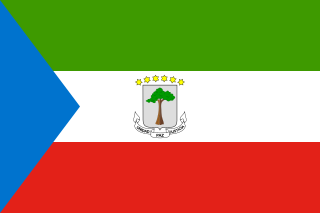
The flag of Equatorial Guinea was adopted on August 21, 1979. The six stars on the flag represent Equatorial Guinea's mainland and five islands. Under the rule of dictator Francisco Nguema the flag was modified and a different national emblem was used in it. After he was deposed the original flag was restored.
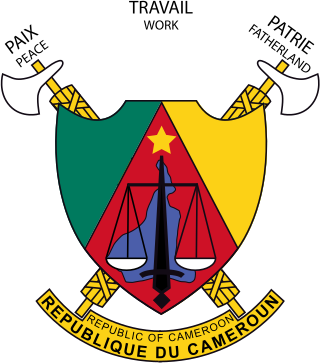
The coat of arms of Cameroon consists of a shield with a banner above and below it. Behind the shield are two crossed fasces. The shield has the same color pattern as the flag of Cameroon, and in the center is a map of the nation. The scales of justice are superimposed on top of the map of the nation since 1984.
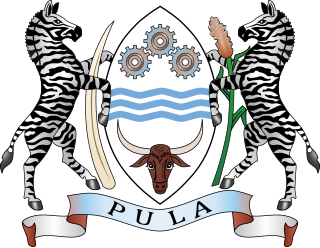
The coat of arms of Botswana was adopted on 25 January 1966. The centre shield is supported by two zebras. The shape of the shield is that of traditional shields found in Southern Africa. On the top portion of the shield are three cogwheels that represent industry.

The seal of the president of the United States is used to mark correspondence from the president of the United States to the U.S. Congress, and is also used as a symbol of the presidency itself. The central design, based on the Great Seal of the United States, is the official coat of arms of the U.S. presidency and also appears on the presidential flag.
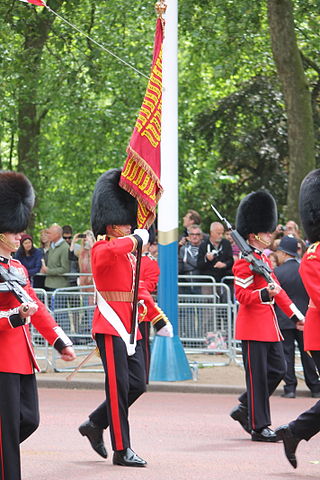
In military organizations, the practice of carrying colours, standards, flags, or guidons, both to act as a rallying point for troops and to mark the location of the commander, is thought to have originated in Ancient Egypt some 5,000 years ago. The Roman Empire also made battle standards reading SPQR a part of their vast armies. It was formalized in the armies of Europe in the High Middle Ages, with standards being emblazoned with the commander's coat of arms.

The coat of arms of Egypt is known as the Republican Eagle or Egyptian Golden Eagle, is a heraldic golden eagle, facing the viewer's left (dexter). The eagle's breast is charged with an escutcheon bearing the red-white-black bands of the flag of Egypt rotated vertically, whilst the eagle's talons hold a scroll bearing the official name of the state written in Kufic script. The earliest version of the Eagle of Saladin was that used as the flag of Saladin, the first Sultan of Egypt, whilst the modern version of the eagle was adopted during the Egyptian Revolution of 1952. Subsequently, the modern design of the eagle of Saladin was adopted as the coat of arms of numerous other states in the Arab World, such as the United Arab Republic, North Yemen, Iraq, South Yemen, the Libyan Arab Republic, and Palestine. The current eagle was modified in 1984 to its present form.
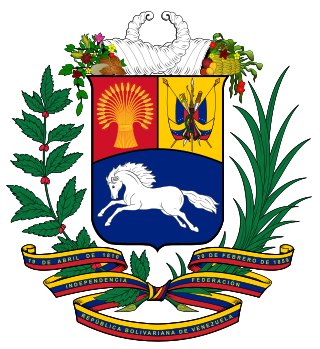
The current coat of arms of Venezuela was primarily approved by the Congress on April 18, 1836, undergoing small modifications through history, reaching the present version.

The Emblem of Iraq since the rule of Baathism features a golden black eagle looking towards the viewer's left dexter. The eagle is the Eagle of Saladin associated with 20th-century pan-Arabism, bearing a shield of the Iraqi flag, and holding a scroll below with the Arabic words جمهورية العراق.
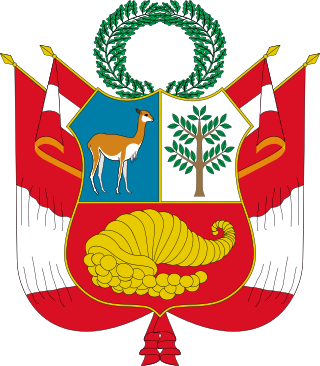
The coat of arms of Peru is the national symbolic emblem of Peru. Four variants are used: the coat of arms per se, the National Coat of Arms, the Great Seal of the State, and the Naval Coat of Arms.

The flag of Philadelphia is a blue and yellow triband featuring the Seal of Philadelphia.

The flag of Sint Maarten consists of a white triangle situated at the hoist charged with the constituent country's coat of arms, along with two horizontal bands of cherry red and navy blue. Adopted in 1985 shortly after the territory was granted a coat of arms, it has been the flag of Sint Maarten since 13 June of that year. Since the dissolution of the Netherlands Antilles on 10 October 2010, it has been the sole flag used in the constituent country.
The flag and the coat of arms of Negeri Sembilan are state symbols of Negeri Sembilan, Malaysia. The symbols are predominantly depicted in red, black and yellow, traditional colours of the Minangkabau people who are the original settlers in the present-day state. Also recognised in the symbols are the political history of Negeri Sembilan, its ruler, and the state's past relationship with the British Empire.

The flag of the president of the United States consists of the presidential coat of arms on a dark blue background. While having the same design as the presidential seal since 1945, the flag has a separate history, and the designs on the flag and seal have at different times influenced each other. The flag is often displayed by the president in official photos, or flown next to the casket of a former president in official funeral processions, and flown on the president's motorcade. The flag is not flown at half-staff since there is always an incumbent president in office. The current flag is defined in Executive Order 10860:
The Color and Flag of the President of the United States shall consist of a dark blue rectangular background of sizes and proportions to conform to military and naval custom, on which shall appear the Coat of Arms of the President in proper colors. The proportions of the elements of the Coat of Arms shall be in direct relation to the hoist, and the fly shall vary according to the customs of the military and naval services.
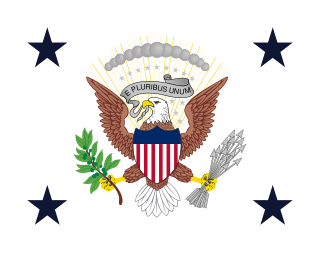
The flag of the vice president of the United States consists of the U.S. vice presidential coat of arms on a white background, with four dark blue stars in the corners. A version of the flag is kept in the vice president's office, is sometimes displayed by the vice president in official photos, and is flown on the vice president's motorcade.

The Emblem of Eritrea was adopted on 24 May 1993 on the occasion of Eritrea's declaration of independence from Ethiopia. The national emblem mainly depicts a camel surrounded by an olive wreath.
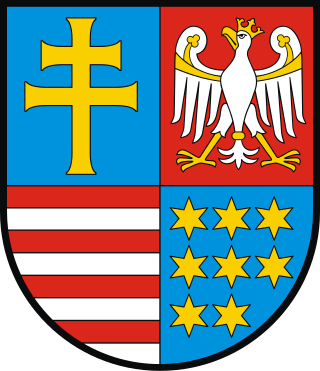
The coat of arms that serves as the symbol of the Świętokrzyskie Voivodeship, Poland, consists of the Iberian style escutcheon (shield), with square top and rounded base, that is divided in the 2 by 2 chessboard pattern. The top left field features a yellow patriarchal cross. The top right field features a white eagle with yellow crown, beak, legs, stripes on its wings, and a ring on its tail. The bottom left field features eight yellow six-pointed starts, placed in three rows, each with three stars, with the exception of the bottom row, that only had 2 stars, placed to the left.